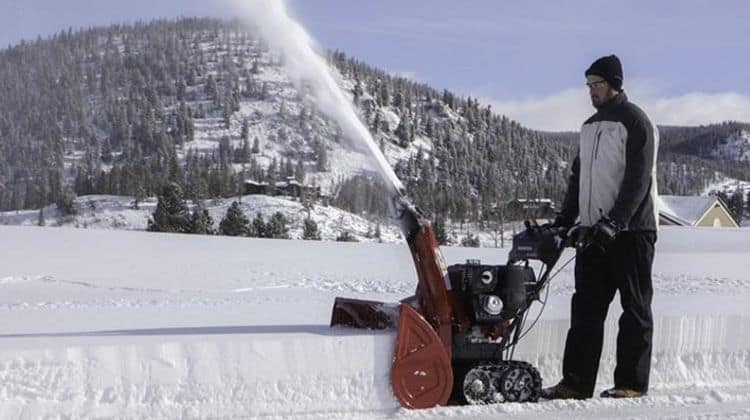In Brief: Two-Stage vs Three-Stage Snow Blowers – Which Is Better?
Two-stage and three-stage snow blowers use steel augers and impellers, but the latter adds an accelerator for crushing ice quickly. Three-stage models are more powerful, throw further, and have larger scoops. Two-stage models are almost as good, but boast a much more affordable price tag and a wider variety.
Two-stage and three-stage snow blowers are the most effective at clearing snow, but how do you know which one is the right fit for you?
We have put together this guide to help you decide whether you should get a two-stage or three-stage snow blower.
Differences Between Two-Stage and Three-Stage Snow Blowers
The table below outlines the key differences between two-stage and three-stage snow blowers, for quick reference.
Read on below for a more detailed discussion on how these types of snow blowers measure up.
| Feature | Two-Stage Snow Blower | Three-Stage Snow Blower |
|---|---|---|
| How It Works | Steel auger and impeller. | Steel augers, accelerator, and impeller. |
| Engine Power | Wide range of engines. | Mostly 420 CC engines. |
| Compacted Snow and Ice | Can deal with hard snow. | Far more efficient through hard snow. |
| Throwing Distance | Up to 50 feet. | 50 to 60 feet. |
| Clearing Width | Wide range of widths. | Only wide machines. |
| Clearing Depth | Limited snow depths. | Suitable for deep snow. |
| Sloped Terrain | Can struggle on inclines. | Deals well with difficult slopes. |
| Ease Of Use | Lighter and maneuverable. | Engine-assisted propulsion. |
| Storage | Slightly easier to store. | Slightly harder to store. |
| Price | Wide range of price points. | More expensive across the board. |
Two-Stage vs Three Stage: Difference in Working
Two-stage snow blowers use a steel auger to cut through ice and snow. The auger passes the snow to the back of the scoop where the impeller propels it out of the chute.
The auger also assists with propulsion, helping to move the heavy machine through the snow as you push it.
Three-stage snow blowers do the same thing, but they have another auger. This auger, also called an accelerator, sits vertically and serves to crush ice and compacted snow before it gets to the impeller.
Many have engine-driven propulsion rather than the auger-assisted propulsion common on two-stage models.
Two-Stage vs Three Stage: Engine Power

The average engine power for three-stage snow blowers is higher than that of two-stage snow blowers, but in broad terms, they are more similar than you might think.
The narrow range of three-stage snow blowers available tends to use big engines around 420 CC, with few exceptions.
The addition of an accelerator auger and the requirement for engine-driven propulsion means that engine sizes smaller than that will not suffice.
Most two-stage models have engine sizes between 200 CC and 300 CC, but some two-stage models come with 420 CC engines, too.
Those models, lacking the accelerator auger and related power requirements, can outperform three-stage models in moderate snow conditions.
Two-Stage vs Three Stage: Effectiveness on Compacted Snow & Ice
When it comes to tackling compacted snow and ice, three-stage models are far superior to their two-stage cousins.
Both types commonly use serrated steel augers to cut through compacted snow and ice, making them far more suitable for these conditions than single-stage snow blowers.
However, the addition of an accelerator auger to the three-stage models greatly increases their ice-crushing power.
If you have to tackle compacted snow and ice, either type will get the job done. However, it will be much quicker and far less effort if you use a three-stage snow blower.
Throwing Distance Comparison between Two and Three Stage Snow Blowers

Two-stage snow blowers can throw the snow they clear up to 50 feet away and three stage one can throw it even further with ease.
For most people, 50 feet will be far enough to ensure that you are not just moving snow onto another part of your driveway, but for some people, it will not be quite enough.
Three-stage snow blowers can often throw the snow more than 50 feet away, though 50 to 60 feet is common.
The extra throwing distance might be relevant if you have a very large driveway or yard to clear, so you should consider that before deciding.
Two-Stage vs Three Stage: Clearing Width & Depth
In terms of clearing width, the wide range of two-stage snow blowers available means that there are comparable clearing widths available in both types.
If you need a narrower machine then you will almost certainly require a two-stage snow blower over a three-stage snow blower.
Depth is a different story. Three-stage snow blowers can tackle depths up to 4 inches more than comparable two-stage models, simply by being larger machines with larger scoops.
As with throwing distance, the margin is slim but could be significant if you live in an area that gets very deep snow every year.
Effectiveness of Two vs Three Staged on Sloped Terrain
Clearing snow from sloped terrain presents its own issues. Traction can be a significant factor in the performance of a snow blower. Its significance is far greater when tackling sloped terrain.
Two-stage models do not usually have engine propulsion. Instead, the large steel auger helps to propel the machine forward as it catches the snow.
The rest of the propulsion comes from your manual pushing power.
Three-stage models often use engine-driven propulsion, taking the load off you. As a result, getting the machine up a slope becomes far easier with three-stage models.
Tracks, rather than wheels, are also more common on three-stage models. If you have a lot of slopes to clear snow from, you may be better served by a tracked model.
Two-Stage vs Three Stage: Ease Of Use

Two-stage snow blowers are generally smaller and lighter than three-stage models, which makes them easier to maneuver. However, being manually driven in most cases, how long you can comfortably use it will depend on your physical fitness.
Three-stage snow blowers are more cumbersome but also tend to come with all the bells and whistles one might expect from a high-end machine.
These include heated handles, power steering, engine-driven propulsion, and joystick-controlled chutes.
Ease of Storage of Two vs Three-stage
Three-stage snow blowers are harder to store than two-stage models, owing primarily to their size. Before buying any two-stage or three-stage snow blower, ensure you check the dimensions.
You will need to plan somewhere to keep the snow blower when it is not in use and, unlike single-stage snow blowers, you will need a space bigger than for a lawnmower.
As both use 4-stroke gas engines, you will need to learn about storing fuel and caring for gas engines whichever model you opt for.
Price comparison:Two-Stage vs Three Stage
Two-stage snow blowers are more affordable than three-stage snow blowers, even for comparable models.
Furthermore, the wide range of available two-stage snow blowers means that there will be a model at the right price point for you, whatever your budget might be.
You can expect to pay somewhere between $1100 and $2800 for a three-stage model, whereas you can pick up a two-stage model for as little as $425.
At the high end, you can get a 420 CC two-stage model for $1600.
These are comparable in power to the biggest three-stage models.
When considering the price, you should decide whether the time and effort saved by owing a three-stage model will provide enough value to offset the extra $500 to $1000 you will likely have to spend.
Who Should Use A Two-Stage Snow Blower, And When?
You should opt for a two-stage snow blower if you deal with moderate snowfall several times a year but do not need to get through large amounts of compacted snow and ice.
Unless you need the added efficiency of the accelerator auger, the money you will save on a two-stage snow blower will outweigh the benefits of getting the more expensive type.
They are typically more suited to residential use and can be more easily stored during the summer.
Who Should Use A Three-Stage Snow Blower, And When?
You should opt for a three-stage snow blower if you need to clear large amounts of heavy, compacted snow and ice.
- If you have a very large driveway, the extra throwing distance could be a significant factor, too.
- If you need a snowblower for commercial purposes, you will almost certainly want a three-stage machine.
The added efficiency when working through large amounts of snow on difficult terrain will save you enough time to make the added expense worth it.
Summary
We hope this guide has helped you understand the differences between two-stage and three-stage snow blowers.
Now that you know how these two types of snow blowers stack up, you are much better placed to decide which one is right for you.
If you have any questions or comments about this guide or snow blowers in general, please feel free to leave them in the comments section below.


